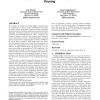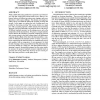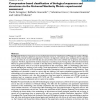103 search results - page 18 / 21 » Comparing Massive High-Dimensional Data Sets |
CIKM
2006
Springer
13 years 11 months ago
2006
Springer
We consider the problem of finding highly correlated pairs in a large data set. That is, given a threshold not too small, we wish to report all the pairs of items (or binary attri...
SDM
2011
SIAM
12 years 10 months ago
2011
SIAM
In this paper we present a fast and accurate procedure called clustered low rank matrix approximation for massive graphs. The procedure involves a fast clustering of the graph and...
KDD
2005
ACM
14 years 7 months ago
2005
ACM
While scalable data mining methods are expected to cope with massive Web data, coping with evolving trends in noisy data in a continuous fashion, and without any unnecessary stopp...
BMCBI
2007
13 years 7 months ago
2007
Background: Similarity of sequences is a key mathematical notion for Classification and Phylogenetic studies in Biology. It is currently primarily handled using alignments. Howeve...
ISBI
2008
IEEE
14 years 8 months ago
2008
IEEE
Multi-subject analysis of functional Magnetic Resonance Imaging (fMRI) data relies on within-subject studies, which are usually conducted using a massively univariate approach. In...



